Operational Analysis Report on Shanghai Housing Provident Fund in 2013
In 2013, the municipal provident fund center proactively implemented the resolutions of the 18th CPC National Congress and the Third Plenary Session of the Eighteenth Committee of the CPC, and explored and innovated for transformational development by seizing on the party’s mass line education campaign, resulting in sound development and improvement of the housing provident fund system, smooth operation of main services indexes, leapfrog growth of both collection amount and paying employees, and increasing expansion of withdrawal and lending. Liquidity equilibrium was maintained, loan risks harnessed, and stable growth of value-added proceeds attained.
1. Accomplishments of Various Services Indexes
Housing Provident Fund Collection: Collection of municipal housing provident fund and additional provident fund in 2013 increased by 15.31% year-on-year to 64.165 billion yuan, including 49.754 billion yuan housing provident fund, namely 78% of total collection amount, and 14.411 billion yuan additional provident fund, namely 22% of total collection amount. As of end of 2013, the cumulative collection of housing provident fund and additional provident fund amounted to 418.9 billion yuan.
Housing Provident Fund Payment: The municipal housing provident fund paying units climbed to 0.1642 million as of end of 2013, up 0.0284 million units year on year by 20.91%. Paying employees edged up 0.60 million in size to 5.4758 million, equivalent to 12.30% year on year.
Housing Provident Fund Withdrawal: Withdrawal of housing provident fund totaled 37.637 billion yuan in 2013, up 33.32% year on year, including 29.393 billion yuan withdrawal due to housing consumption (up 38.01% year on year), and 8.244 billion yuan one-off closing-account withdrawal due to causes such as retirement (up 18.92% year on year). The cumulative withdrawal of housing provident fund hit 231.6 billion yuan as of end of 2013, equivalent to 55% of the cumulative collection amount.
Housing Provident Fund Lending: 61.456 billion yuan worth of housing provident fund home loans were lent out in 2013, up 49.75% year on year, to 158700 households, up 41.95% year on year, including 1.556 billion yuan worth of home loans to 5544 affordable housing purchasing households. Housing provident fund home loans balance recorded 178.831 billion yuan as of end of 2013.
In 2013, 4.928 billion yuan worth of housing provident fund loans was lent out to support security housing construction. And cumulative provident fund loans in support of security housing construction amounted to 7.96 billion yuan as of end of 2013, accounting for 66.43% of the entire housing provident fund loans of the municipality endorsed by the central government, as scheduled to bolster municipal security housing construction.
Risks of Housing Provident Fund Loans: The delinquency rate for housing provident fund home loans was 0.122‰ as of end of 2013.
Housing Provident Fund Value-Added Proceeds: Housing provident fund services revenues in 2013 recorded 4.12 billion yuan, up 16.81% year on year.
2. Characteristics of Housing Provident Fund Operation in 2013
(1) Paying employees surged in size, with changes in structure of additional paying employees.
In 2013, the municipal provident fund center adhered to the strategy of transformational development in an innovative approach and stepped up efforts to expand housing provident fund system coverage, taking measures such as creating new working mechanism to give full play to collecting banks in the housing provident fund payment coverage expansion campaign, and changing working methodology to conduct targeted law enforcement inspection of liable paying units in tandem with large-scale promotional activities. Units with newly-opened accounts in 2013 recorded 41,000, up 40% year on year. Employees with newly-opened accounts all through the year hit 894,000, up 37% year on year. Paying employees climbed to 5.4758 million as of end of 2013, with an annual net growth hitting a 10-year new high of 600,000. Following is an illustration of net growth of paying employees during 2005-2013 (in thousand):
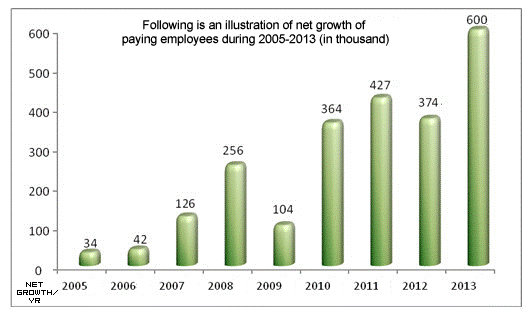
It is noteworthy that net growth of paying employees in 2013 reflects structural changes as follows: (1) Nonlocal employees (with domicile registration in other provinces) recorded 648,000, accounting for an increasingly significant proportion, namely 72% of paying employees with newly-opened accounts in 2013, up 6 percentage points from last year; local employees (with a permanent domicile in this municipality) totaled 246,000, equivalent to 28% of additional paying employees, down 6 percentage points from last year. (2) Paying employees of private businesses grew rapidly in 2013 and hit 1.233 million, followed by 1.099 million for foreign-funded enterprises, 1.011 million for state-owned enterprises, 152,000 for collective enterprises and 1.152 million for other businesses. Paying employees of private businesses grew the fastest, up 38.9% from last year, namely up 12 percentage points from same period of last year. Paying employees of foreign-funded enterprises, collective enterprises and other businesses registered a stable growth, up 10.4%, 8.4% and 8.7% from last year respectively. Paying employees of state-owned enterprises remained almost the same as last year. Following is a diagram showing composition and structure of paying employees of various enterprises in 2013:
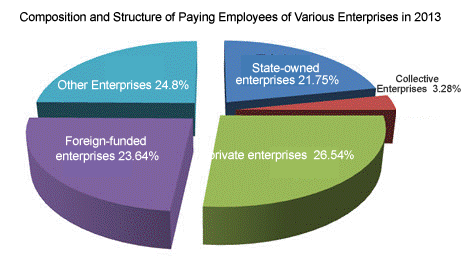
(3) Small-sized enterprises accounted for the largest proportion. Further analysis of composition of paying employees of existing paying units and additional paying units with newly-opened accounts in 2013 indicated that businesses with 1 to 5 paying employee(s) account for a larger proportion, namely 71%, of those units with newly-opened accounts, making a difference of 25 percentage points comparing with 46% for businesses with 1 to 5 employee(s) amongst all paying units, and that additional paying units with newly-opened accounts and over 50 paying employees only account for 2%, down approximately 8 percentage points in comparison with the coverage percentage for those same-scaled businesses amongst all paying units. Following is an illustration diagram showing composition of paying units with newly-opened accounts in 2013:
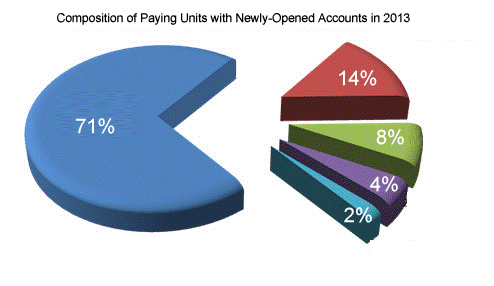
scale of units in terms of headcounts | Coverage rate among paying units with newly-opened accounts in 2013 |
Less than 5 employees | 71% |
5(incl.) to 10 employees | 14% |
10(incl.) to 20 employees | 8% |
20(incl.) to 50 employees | 4% |
50 or more employees | 2% |
(2) Housing provident fund lending for home purchase hit a new record high, overall equilibrium of fund supply and demand was attained through the year.
The municipal commercial property sales edged up in 2013 in both volume and price amid nationwide implementation of macro regulatory policies and continuous release of restraint on rigid demand, prompting a substantial increase in housing provident fund lending for home purchase. Annual home loans lent out registered 61.456 billion yuan, up nearly 50% year on year, comprising 14.668 billion yuan for first quarter, 18.712 billion yuan for second quarter, 15.362 billion yuan for third quarter and 12.714 billion yuan for fourth quarter. Second quarter turned out to be the peak season, with a monthly average of 6.2 billion yuan lent out, and housing provident fund lending indicated a subdued demand in third and fourth quarters, with a monthly average lending of 5.1 billion yuan and 4.2 billion yuan respectively.
The municipal provident fund center took measures to enhance liquidity management in an effort to proactively respond to increasing demand for loans. One measure was to require home loans handling agencies and entrusted banks to keep tabs on reviews of loans applications by strictly observing loans policies in a bid to ensure effective implementation of macro regulatory policies and differentiated credit policies. The other measure was to strengthen market analysis to make good judgment of the dynamic trend of home loans demand, and make timely adjustment of fund supply based on changes of home loans demand, which ensured equilibrium of home loans fund supply and demand through the year and satisfied the home loans demand.
(3) HPF withdrawal increased rapidly, in pace with a constant rise in withdrawal due to movement of nonlocal employees
Municipal housing consumption started to escalate in second half of 2012, prompting a substantial increase by 34% in home loans repayment by means of housing provident fund in 2013. Withdrawal due to home loans repayment accounted for 88% of total withdrawal due to housing consumption, 69% of annual withdrawal amount. The rapid increase in withdrawal due to home loans repayment directly caused a surge of withdrawal due to housing consumption and the aggregated withdrawal. Statistics showed withdrawal due to housing consumption in 2013 upped 38% year on year, equivalent to a rise of 24 percentage points from same period of previous year. Aggregated withdrawal amount upped 33% year on year, namely a rise of 16 percentage points from same period of previous year. Withdrawal due to home loans repayment, withdrawal due to housing consumption and aggregated withdrawal all hit a ten-year new high. Following is a diagram illustrating percentage of increase in three categories of withdrawal between 2004-2013:
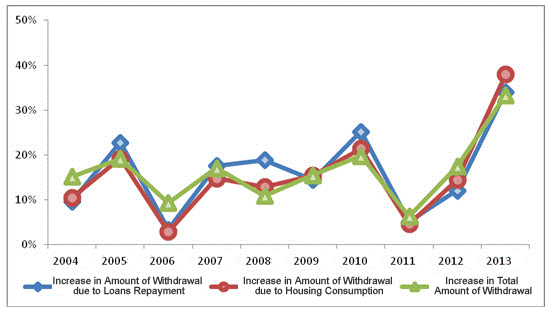
In addition, withdrawal due to account-closing cases also climbed briskly as high as 8.244 billion yuan in 2013, up 19% year on year, amongst which withdrawal of nonlocal employees due to transfer of labor relationship out of the municipality recorded 0.996 billion yuan, equivalent to 12% of the one-off closing-account withdrawal amount. Nonlocal employees’ labor relationship transfer to other provinces prompted an increase of withdrawal amount and person times since 2008 at an average rate of 47% and 44% respectively, and steadily rising proportion of both withdrawal amount and person times amongst the closing-account withdrawal, amid annual growth of nonlocal employees among paying employees and constant transfer of their labor relationship outside the municipality. Following is a diagram showing coverage percentage of nonlocal employees’ withdrawal due to labor relationship transfer amongst closing-account withdrawal:

(4) Value-added proceeds steadily increased, with structure of services revenues gradually optimized.
The municipality’s housing provident fund services revenues in 2013 recorded 9.171 billion yuan, and services expenses totaled 5.051 billion yuan. Housing provident fund value-added proceeds turned out to be 4.12 billion yuan, up 16.81% year on year. The municipal provident fund center tapped new channels and new services actively for preserving and growing value of housing provident fund in a bid to boost services revenues in the backdrop of steady deposit and lending interest rates through the year, which comprised two measures. One measure was to increase services revenues by means of lending out loans in support of security housing construction. Housing provident fund lending for security housing construction projects in 2013 totaled 4.928 billion yuan, up 2.548 billion yuan from previous year, resulting in 0.28 billion yuan worth of additional services revenues. The other measure was to increase revenues by seizing on the opportunity of market-oriented reform of interest rates to optimize allocation of various deposits, including short, medium and long term deposits in a bid to adjust reserve assets’ value preservation methods for higher yield rate under the precondition that all demands for housing provident fund withdrawal and home loans were met. Analysis of composition of housing provident fund services revenues in recent three years indicated that coverage rate of home loans interest income slid in contrast with sustained growth of coverage rates of project loans interest income and fixed deposit interest income, and consequently structure of value-added proceeds was continuously streamlined. Following is an illustration of coverage rates of main HPF services revenues between 2011- 2013:
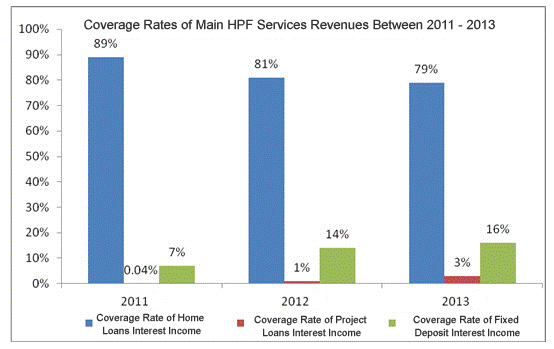
3. Key Issues to Focus on in 2014
In 2014, the municipal provident fund center shall comprehensively implement the spirit of the Party’s 18th CPC National Congress and the Third Plenary Session of the Eighteenth Committee of the CPC, conduct deeper reforms and attain sustainable and sound development of the housing provident fund.
(1) Proactively implement the spirit of resolutions of the Third Plenary Session of the Eighteenth Committee of the CPC with emancipated minds and audaciously explore the opportunities for reforms of the housing provident fund.
Year 2014 is the year of reform alongside with implementation of the spirit of the Third Plenary Session of the Eighteenth Committee of the CPC. Decision of CPC Central Committee on Several Important Issues Concerning Comprehensively Deepening Reforms clarified on the approach to the reform for establishment of open standards for housing provident fund system and improvement of housing provident fund withdrawal, use and monitoring mechanism. The municipal provident fund center shall actively explore the opportunities for reform and development of housing provident fund system with emancipated minds to further improve housing provident fund system under the guidance of the Decision.
(2) Keep tabs on key issues and continue to step up efforts to expand housing provident fund payment coverage.
In 2014, the municipal provident fund center shall focus on key issues and step up efforts to expand housing provident fund payment coverage in view of new situation and new problems arising from urban-rural integrated development of the municipality and on basis of analysis of the experience gained through the past year’s payment coverage expansion practice. Extensive and effective publicity campaign shall be launched to boost enterprises’ initiatives to make housing provident fund payment. Law enforcement shall be strengthened, normalized law enforcement mechanism shall be created and ad hoc law enforcement activities shall be rolled out for inspection of key industries or domains, in a bid to safeguard employees’ legitimate rights and interests.
(3) Manage to retain stable housing provident fund credit lending policies and enhance surveillance and administration.
In 2014 work deployment plan, Ministry of Housing and Construction underscored keeping on property market regulatory control and monitoring, retain continuity and stability of the regulatory policies, and execute existing regulatory measures. The municipal provident fund center shall resume strict execution of differentiated provident fund credit lending policies based on the actual situation of the municipality, retain continuity and stability of housing provident fund home loans policies, and bolster self-occupied and/or improvement-oriented home purchase. In the meantime, efforts shall be made to strengthen supervision and surveillance of housing provident fund home loans processing by relevant handling agencies and entrusted banks, in a bid to make housing provident fund home loans processing standardized and transparent.
(4) Further relax housing provident fund withdrawal and use policies and proactively boost housing consumption of paying employees.
In 2014, the municipal provident fund center shall further relax policies and raise limit for withdrawal due to housing provident fund payment for housing rent and property service charges, bolster housing provident fund paying employees’ self-occupancy housing consumption and mull over streamlining process of and procedures for housing provident fund withdrawal due to retirement and home purchase, as per requirements for improvement of housing provident fund withdrawal and use as illuminated in resolutions of the Third Plenary Session of the Eighteenth Committee of the CPC, in an aim to better facilitate withdrawal service to employees.
(5) Persevere in mass line practice and upgrading service standards.
Year 2014 is the last year for executing Three-Year Action Plan for Enhancing and Improving Housing Provident Fund Services in this municipality. The municipal provident fund center shall fully utilize informatization measures in a move to initiate and offer more services conducive to paying units and employees, such as rollout of more online services, comprising new self-query service coupled with existing query services via webpage access, smartphone app and phone call in a bid to further improve service outlets’ environment, reduce lineup stress, streamline service experience and comprehensively improve provident fund service efficiency and standards.
Shanghai Provident Fund Management Center
January 2014

